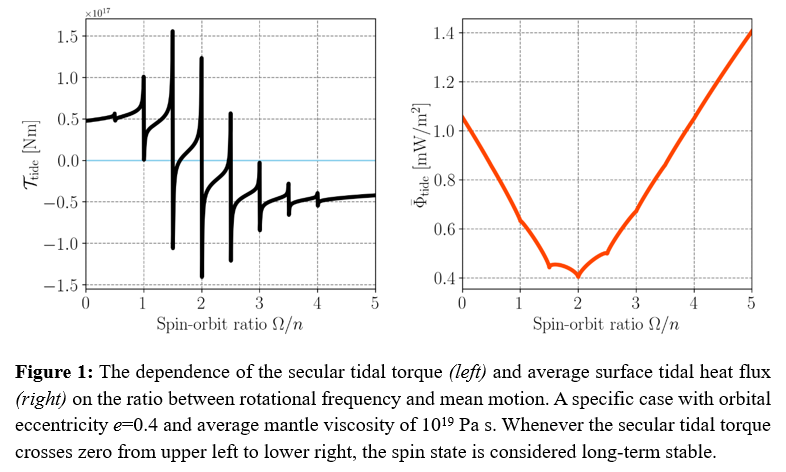Stable spin states and tidal heating of ancient Mercury
- Department of Geophysics, Faculty of Mathematics and Physics, Charles University, Prague, Czechia (kanovami@gmail.com)
The innermost planet of the Solar System is currently locked in the 3:2 spin-orbit resonance, which means that it undergoes exactly three rotations around its axis within two revolutions around the Sun. This unique spin state results in longitudinal variations of the average surface temperature as well as in a specific topographic pattern [1,2]. However, as indicated by the surface cratering record [3,4], Mercury might not have always been in the present-day resonance. According to this indirect evidence, it is likely that it experienced a period of rotation in the 1:1 or 2:1 spin-orbit resonance, at least early in the history. An alternative explanation sees the cratering record as determined by tectonic processes and places the attainment of the 3:2 resonance to the earliest days of the planet, considering it primordial [5].
The stability of spin-orbit resonances depends on the orbital eccentricity, the interior structure, and the thermal state of the planet. Gravitational perturbations induced primarily by the gas giants are able to drive Mercury’s orbital eccentricity to values as high as 0.5 within 4 Gyr of evolution [6]. Likewise, the thermal state of Mercury has been changing over time as a consequence of secular cooling. In this study, we focus on the secular tidal torque acting on Mercury and analyse the long-term stability of possible past spin-orbit resonances at different orbital eccentricities and different interior temperatures. Mercury is treated as a differentiated viscoelastic sphere with radial interior structure consistent with the latest observational data [7,8] and its tidal deformation is calculated semi-analytically, using the methods of the normal mode theory [e.g., 9]. Tidal deformation, parameterised by the Love number k2 and the phase lag ε2 at multiple frequencies, is then used to evaluate the secular tidal torque and determine for which spin-orbit resonances it equals zero (Figure 1). Additionally, since the combination of high eccentricity and increased interior temperatures might lead to increased tidal dissipation, we also follow in the steps of [10] and discuss the contribution of tidal heating to the heat budget of the planet.

Acknowledgement
The work on this project has been supported by the Czech Science Foundation grant nr. 23-06513I.
References
[1] Vasavada et al. (1999), Icarus, 141(2):179-193, doi: 10.1006/icar.1999.6175.
[2] Becker et al. (2016), Contribution No. 1903, p.2959 t, 47th Lunar and Planetary Science Conference, held March 21-25, 2016 at The Woodlands, Texas.
[3] Wieczorek et al. (2012), Nature Geoscience, 5(1):18-21, doi: 10.1038/ngeo1350.
[4] Knibbe & van Westrenen (2016), Icarus, 281:1-18, doi: 10.1016/j.icarus.2016.08.036.
[5] Noyelles et al. (2014), Icarus, 241:26-44, doi: 10.1016/j.icarus.2014.05.045.
[6] Laskar & Gastineau (2009), Nature, 459(7248):817-819, doi: 10.1038/nature08096.
[7] Genova et al. (2019), Geophysical Research Letters, 46(7):3625-3633, doi: 10.1029/2018GL081135.
[8] Goossens et al. (2022), The Planetary Science Journal, 3(2): id.37, doi: 10.3847/PSJ/ac4bb8.
[9] Takeuchi & Saito (1972), Methods in Computational Physics, 11:217-295, doi:10.1016/B978-0-12-460811-5.50010-6.
[10] Rivoldini et al. (2010), abstract nr. EPSC2010-671, European Planetary Science Congress 2010, held 20-24 September in Rome, Italy.
How to cite: Walterová, M.: Stable spin states and tidal heating of ancient Mercury, Europlanet Science Congress 2024, Berlin, Germany, 8–13 Sep 2024, EPSC2024-227, https://doi.org/10.5194/epsc2024-227, 2024.